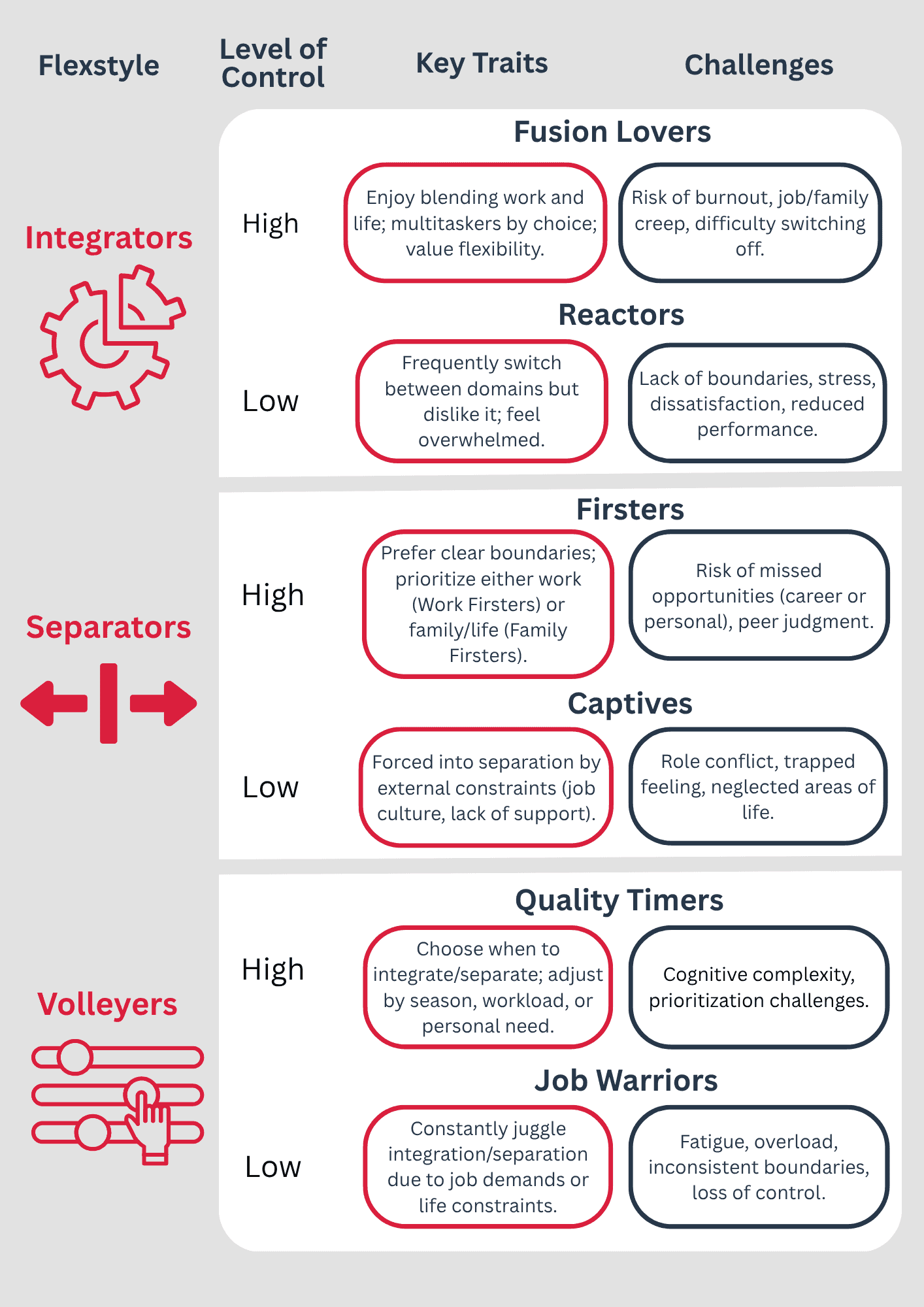Work-Life Balance Isn’t One-Size-Fits-All: Discover Your Flexstyle
In today’s increasingly blurred boundaries between work and personal life, people manage the interaction between these two spheres in different ways. Professor Ellen Ernst Kossek (“The CEO of me”), a leading expert in work-life integration, introduced the concept of flexstyles—individual preferences for managing work-life boundaries—emphasizing that the key to well-being lies not in a “right” style, but in feeling in control and aligned with personal values.
Three Core Flexstyles
1. Integrators
Integrators blend work and non-work responsibilities throughout the day. They mentally and physically shift between the two domains, often responding to family during work hours or handling work tasks in personal time. While some Integrators, like Fusion Lovers, thrive on this fluidity, as they see the two roles enriching each other, others like Reactors—feel overwhelmed, lacking control, and would rather keep work and personal life separate.
2. Separators
Separators prefer to keep work and life distinct. They mentally and physically separate roles—for example, avoiding work emails at home or keeping a strict schedule. They also prefer not to socialise with colleagues in their own time and don’t discuss work at home. Some separators as the Firsters are content in this separation and prioritize either family or work deliberately. Other, like the Captives, feel stuck in a rigid routine due to job or personal demands and lack the power to adjust.
3. Volleyers
Volleyers shift between integration and separation depending on the demands of the moment. Quality Timers manage this flexibly, aligning work and life with time-based cues like seasons or workloads. Job Warriors face high switching costs and workload pressures, often experiencing fatigue and a sense of loss of control.
Each flexstyle can be experienced positively or negatively depending on how much control the individual feels they have.
- High-control subtypes (e.g., Fusion Lovers, Firsters, Quality Timers) align well with personal values.
- Low-control subtypes (e.g., Reactors, Captives, Job Warriors) are typically stressed, burned out, or disconnected from personal goals.

Flexstyles and self-awareness
Shifting one’s flexstyle requires more than awareness—it requires motivation and action. Key questions to ask include:
- To what extent is my current flexstyle draining time and energy away from what really matters to me?
- Do the tradeoffs and stress outweigh the benefits I am receiving?
- Do my family, friends, or coworkers who are affected by my flexstyle think I need to make changes?
- Can I envision more effective ways of managing my life that I would like to try?
- Can I envision the barriers to change, and am I willing to surmount them?
- Can I identify resources (money, people, knowledge, and so on) that may help me make a change?
If you answered “yes” to several these questions, you are probably ready to commit to changing your flexstyle.
Some ideas for healthier flexstyle management:
- All flexstyles have trade-offs. Explore yours and decide if it works for you right now
- Make a conscious choice—don’t let others define your flexstyle.
- Consciously make a choice on which flexstyle would offer you the best alignment with your values!
- If minor changes aren’t enough, a major style shift—or even reducing workload—may be needed.
- Life transitions are natural points for reassessing your flexstyle.
Practical tips
Each flexstyle carries distinct challenges, but strategies can help reduce strain:
- Fusion Lovers: Track and limit breaks, review boundaries regularly.
- Reactors: Communicate limits, avoid constant switching.
- Family Firsters: Protect work visibility while preserving personal priorities.
- Job Warriors: Use transition times and focus on what matters at home.
- Captives: Practice stress management and seek long-term changes.
In the end, success lies in designing a personal strategy that aligns with your values, allows for sustainable energy, and supports a fulfilling life across both work and personal domains.
